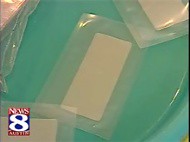The ADHD patch.
According to the American Academy of Pediatrics, ADHD is one of the most common chronic conditions of childhood and affects between 4 percent and 12 percent of all school-age children.
About three-times more boys than girls are diagnosed with ADHD. Attention Deficit Hyperactivity Disorder, or ADHD, is a dysfunction in certain parts of the brain. Researchers believe ADHD originates in the impulse control areas of the brain’s frontal lobes. It’s these areas that seem to be responsible for regulating the rest of the brain. Children with ADHD may experience significant functional problems such as school difficulties, academic underachievement, troublesome relationships with family members and peers, and behavioral problems.
Medications including Ritalin, Adderall, Dexedrine, and Cylert are used to treat the disorder.
A new patch system delivers methylphenidate -- the main ingredient in some of the ADHD drugs -- throughout the day. It is the first drug that does not have to be taken orally.
WATCH THE VIDEO
More Information
A patch for ADHD
A patch is being developed to replace oral medication for ADHD.
New research reveals the patch works at least as well as standard ADHD drugs Sharon B. Wigal, director of clinical trials at the Child Development Center at the University of California, Irvine, led one of the studies.
Study investigators gave the patch to 80 kids with ADHD between ages 6 and 12. Half the kids received an inert placebo patch and later switched to a real patch. The other half started with a real patch and later switched to a placebo. When getting the real patch, the children's ADHD was significantly better than when they got the fake patch. Their behavior and attention, tested throughout the day, improved. They also did better on age-adjusted math tests. Children in the study are continuing to use the patch for a full year.
In another study out of University Hospitals of Cleveland, Dr. Robert L. Findling, director of child and adolescent psychiatry, and colleagues, compared the patch with placebo as well as with methylphenidate pills. The patch and methylphenidate pills improved 6- to 12-year-old kids' ADHD better than placebo. ADHD scores actually improved more with the patch than with the pills, although the difference was not considered significant.
The patch may allow clinicians to formulate doses to individual patients and offers parents more control over how long they want the stimulant medication to last.
Even though Wigal's study involved removing the patch after nine hours, parents may opt to remove it earlier or later once they administer it themselves, as the patch continues to work after the 12-hour point and possibly up to as long as 16 hours. Researchers say it looks as though the patch must be removed for three hours before its effects wear off.
The patch does have side effects -- comparable to what is seen with other stimulant drugs. These include effects on sleep and skin reactions.
Thursday, March 02, 2006
PATCH FOR ADHD??? JUST ANOTHER WAY FOR THE DRUG INDUSTRIES TO MAKE HUGE MONEY!!!!
Subscribe to:
Post Comments (Atom)

No comments:
Post a Comment